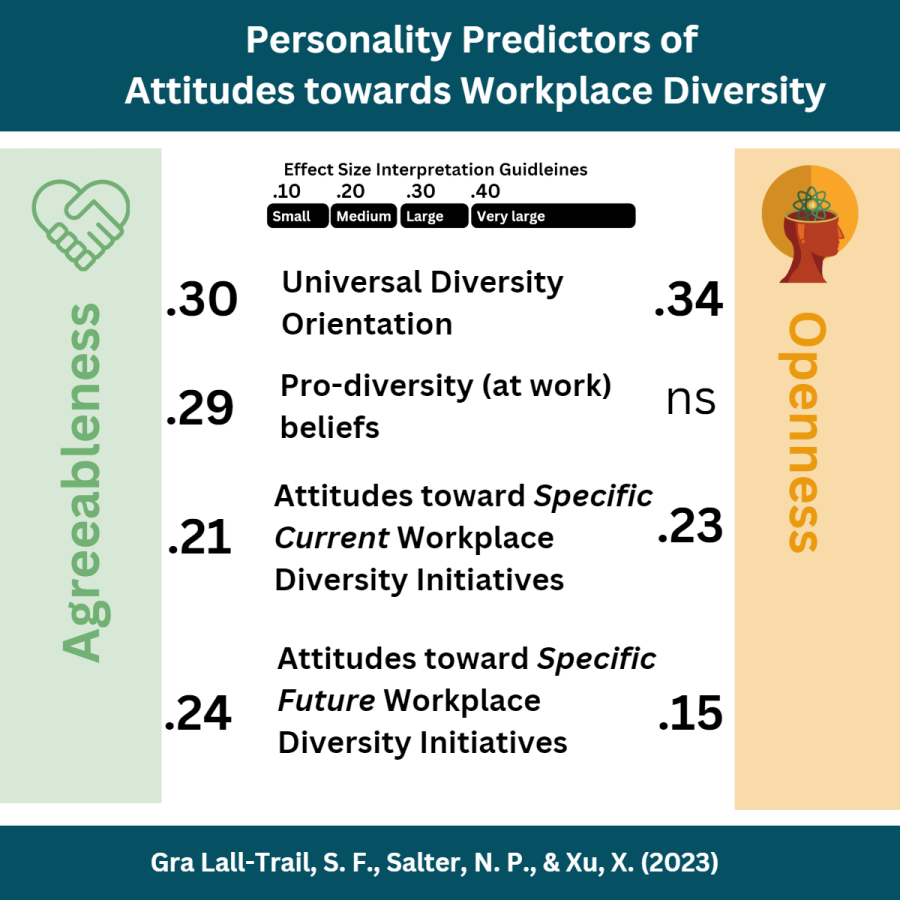There are many ways to build an inclusive work environment. This article focuses on one of them: Hiring people who are high on personality traits that predict inclusive thoughts, feelings, and behaviors.
The Power of Personality
A large body of research has shown that personality is a powerful predictor of pretty much any outcome that should be of great interest and value to an organization. A partial list of such outcomes:
- job performance
- organizational citizenship behavior
- counterproductive work behavior
- turnover
- employee engagement
- job satisfaction
- burnout
- creativity
- leadership effectiveness
A recent study¹ has added to the above list, showing that personality is also a strong predictor of attitudes towards workplace diversity.
Personality Predictors of Attitudes toward Diversity (and by extension) Inclusion in the Workplace
The study found:
- Agreeableness and Openness had large relationships with Universal Diversity Orientation, which consists of an individual’s overall beliefs and attitudes towards diversity (e.g., how important it is to be around different types of peoples and cultures).
- Agreeableness was a powerful predictor of having Pro-Diversity Beliefs, which measures how positively people respond to diversity practices in the workplace.
- Agreeableness also predicted having positive attitudes to both existing workplace initiatives and future workplace initiatives (e.g., using preferred pronouns, attending diversity trainings, inclusive bathroom signs). A deeper dive into the results showed that the predictive power of Agreeableness was primarily driven by the Compassion Aspect, which consists of feelings of concern for the well-being of others.

Practical Implications:
Because personality is such a strong predictor of so many outcomes, a measure based on the Big Five or HEXACO model should already be part of your system for employee selection and development. Knowing where an individual falls on these two domains, especially Agreeableness, has several practical implications.
- Individuals who are lower in O and, especially A, are likely to be less receptive to DEI efforts and will benefit from having such initiatives framed differently. This is because research has shown that people tend to be more responsive to messages that are congruent with their personality. For those lower in O and/or A, the initiative may need to be tied into how it will help to uphold the company’s tradition of valuing community and culture, how it ties into profitability, or even more directly, how it will benefit them personally.
- Those who are high in both A and O are more likely be champions of DEI who will be more engaged in such initiatives. Inviting these individuals to participate in relevant committees or to help serve as advocates who can get others on board may help with the creation of valuable ideas and support.
- If problems are noticed with an individual’s behavior towards DEI initiatives, knowing where they stand on A and O can be helpful in determining what type of an intervention may be needed. For example, if someone who is displaying problem behavior is low on O and A, they will require more intensive development (especially if they are low on both), as the issues are being caused by a core aspect of who they are.
- Given that low Agreeableness is associated with a range of negative other negative outcomes, organizations should think carefully about hiring individuals who have notably low scores on this domain, especially for higher level leadership roles. If such individuals are hired, it is better to be proactive and provide them with more intensive coaching and development to help to avoid possible issues.
¹https://pubmed.ncbi.nlm.nih.gov/34930046/ Lall-Trail, S. F., Salter, N. P., & Xu, X. (2023). How personality relates to attitudes toward diversity and workplace diversity initiatives. Personality and Social Psychology Bulletin, 49(1), 66–80
Read More about the power of personality…


